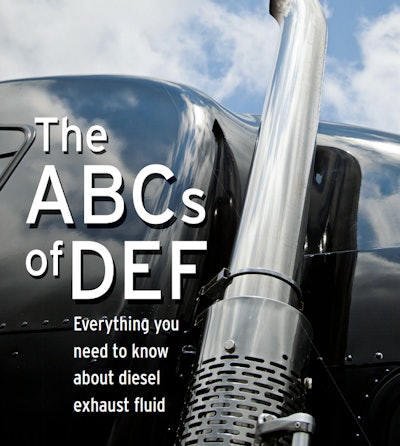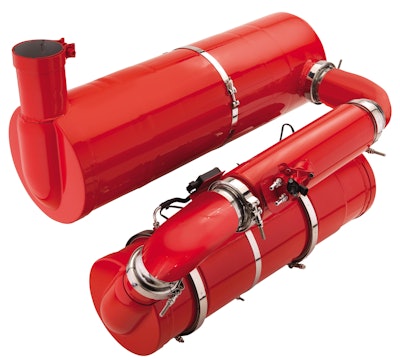The following comes from the July 2016 issue of Truck Parts & Service. To read a digital version of the magazine, please click the image below.

This article was updated Aug. 11, 2020, to reflect the most current information.
When it was first introduced in 2010, diesel exhaust fluid was touted as a miracle cure. A secret ingredient. The answer to trucking’s multi-billion dollar emission question.
In the aftermarket it went from an unknown product to a must-stock item, and today the solution known as DEF can be found at distribution facilities, big box retailers and fueling stations nationwide.
Everyone carries it, nearly all aftertreatment systems require it and diesel particulate filters don’t stay clean for long without it.
But ask a driver or counterperson how it works and you’ll be surprised at some of the responses. Diesel exhaust fluid might be universal, but it’s hardly universally understood.
 Cummins’ selective catalytic reduction (SCR) system works with DEF and a diesel particulate filter (DPF) to reduce emissions.
Cummins’ selective catalytic reduction (SCR) system works with DEF and a diesel particulate filter (DPF) to reduce emissions.For aftermarket businesses who’d like to know more about the fluid they’re selling, the story of DEF begins with SCR.
What is DEF, and why is it needed?
Diesel exhaust fluid is a simple solution of 67.5 percent deionized water and 32.5 percent high-purity urea, and works with selective catalytic reduction (SCR) systems to reduce Nitrous Oxide (NOx) emissions from diesel engines.
The mixture was first introduced in the commercial trucking industry late last decade by engine manufacturers as a means to achieve — with SCR — the then-proposed U.S. Environmental Protection Agency (EPA) 2010 medium- and heavy-duty emission standards.
In a Q&A bulletin from that time, Cummins Filtration described the partnership between SCR and DEF as follows: “SCR is the aftertreatment technology that treats exhaust gas downstream of the engine. Small quantities of diesel exhaust fluid are injected into the exhaust upstream of a catalyst, where it vaporizes and decomposes to form ammonia and carbon dioxide. The ammonia [NH3] is the desired product which in conjunction to the SCR catalyst, converts the NOx to harmless nitrogen [N2] and water [H2O].”
“What you’re trying to do with DEF is alter the chemistry” within an aftertreatment system, says Allen Schaeffer, executive director at the Diesel Technology Forum. By inserting properly formulated DEF into a closed SCR system at an optimal temperature, Shaeffer says NOx is quickly transformed, and results in emissions that are “as clean as or cleaner than the air going in” to an engine.
DEF is formulated at 32.5 percent urea to provide the fluid the lowest possible freeze point, and SCR systems are calibrated to 32.5 percent “so that optimum NOx will be reduced during operation,” Cummins says.
Similar to oil, DEF formulation and quality is monitored by the American Petroleum Institute (API).
Using a purity standard published by the International Organization for Standardization (ISO), API’s Diesel Exhaust Fluid (DEF) Certification Program is “intended to ensure that the diesel exhaust fluid used in SCR-equipped cars and trucks provides the purity required by diesel engine manufacturers and the quality to preserve the emissions control system and the environment.”
Every factory fill DEF in North America has been certified by API.
Maintaining a DEF system
Though today’s aftertreatment systems are among the most costly systems to for truck owners to maintain, very little of that expense is traced back to DEF issues.

But the lack of driver input doesn’t make the system impervious to failure. Improperly mixed DEF and/or debris within a DEF tank can impact dosing rates and weaken the performance of the entire aftertreatment system, says Zachary Stogdill, equipment manager at PEAK Commercial and Industrial. Failed sensors do the same.
Cummins says its SCR systems recognize solutions other than DEF and when polluted trigger a cab indicator light to inform drivers. Unfortunately dust or microscopic particulate contamination can take longer to be identified.
“It’s all about maintaining a closed system,” Schaeffer says. “You don’t know you have a problem until something shows up in the engine.”
Dunnuck says Cummins’ aftertreatment system also has built-in filters between the DEF tank and SCR system but says the safest way to avoid contamination remains in the hands of vehicle operators. Because DEF is typically added during fueling stops — and used at a rate of 2 percent compared to diesel fuel — Dunnuck says Cummins advises all drivers to take the same anti-contamination precautions they do when refueling.
Additional cleaning intervals, either during preventive maintenance stops or independently, also are recommended.
“We have a lot of products in very dusty environments where the [contamination] risk is high,” says Dunnuck. “If you get enough debris in there over time, it can clog up a [DEF] filter just like it would a fuel system.”
This is an area where aftermarket service providers can capitalize. Adding DEF tank and aftertreatment system cleaning into PM stops takes just minutes, and provides customers unfamiliar with the technology valuable piece of mind.
DEF management
Because it’s more than two-thirds water, Cummins says DEF does carry a minor risk of evaporation or freezing in extreme temperatures, particularly when in bulk storage containers. Dunnuck says the company recommends storing DEF at 77˚F and out of direct sunlight. Testing has determined the fluid has a shelf life of more than six months when stored in extreme heat (95˚F). It also has a freeze point of 12˚F.
Cummins says when the fluid’s formula is compromised it should be discarded. “If the urea concentration does become more or less than recommended over time, the DEF tank should be drained,” the company says.
DEF also poses minor risks outside of a tank.
Though the fluid is nontoxic, nonpolluting, nonhazardous and non-flammable, the urea portion is corrosive to copper, brass and other materials. Cummins recommends any washing or rinsing any corrosive surfaces that come in contact with DEF — including truck bodies and fl oor drains — to minimize these risks.
Dunnuck says Cummins uses corrosion-resistant materials such as high density polyethylene (HDPE) for its DEF tanks and hoses, and recommends all bulk distributors and end users do the same.
A common sense approach can go a long way, Schaeffer says.
“You can’t totally ignore [DEF] but it’s not something vehicle operators should have to worry about,” he says. “It’s a pretty simple system and it works quite well.”











